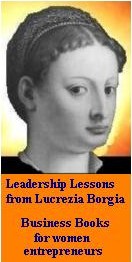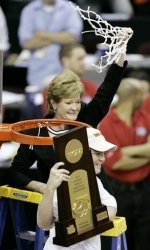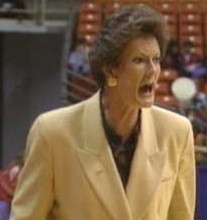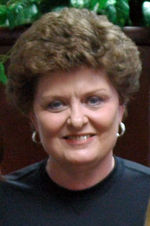|




|
Women's College Basketball Standard Bearer: A BIOGRAPHY OF PAT HEAD SUMMITT
July 6, 200
New video added: Pat coaching her son's AAU team. "You can't say "You can't" to me."
Latest Lady Vols Videos
On April 3, 2007, the Lady Vols won their 7th national championship, as #7 in '07 was the rally cry for fans around the world.
On June 9, it was announced that the 10 year UConn-Tennessee rivalry was no more, as Summitt would no longer be scheduling the game. Ironically, a book on this marquee rivalry -- the most anticipated woman's college basketball game all year -- is due to be published in November, 2007.
June 21, 2007
Pat Summitt fainted at her home and was taken to the hospital for observation. It is assumed she became dehydrated due to to working a basketball camp in a gym without airconditioning.
WBIR article
MSNBC article
Below is a biography of Pat Summitt and a history of women's basketball.
Go to Complete biography, with no extra basketball history for Summitt's biography only. |

Buy Now |
Overview
Lady Vols coach Pat Summitt has achieved several milestones in her 33-year career:
Most wins by a Division I college basketball coach, male or female
Most NCAA championships by a women's basketball coach at 7 (ahead of Geno Auriemma of UConn who has won 5), and only 3 behind the great men's basketball coach, John Wooden.
Over half of her wins have come against ranked opponents - the Lady Vols typically play the most difficult schedule of any WCBB team - Summitt thrives on challenge and competition.
Gives motivational speeches on her coaching/life philosophy: The Definitive Dozen.
Summitt started coaching the Lady Vols when the NCAA wasn't even interested in women's basketball, and in the years since has competed with her peers and built one of the most prestigious, if not the most prestigious WCBB teams in the country, the Tennessee Lady Vols.
How did she do it?
This is a biography of Pat Head Summitt, told in 5 pages. Of necessity, it's also a biography of the coming of age of women's college basketball and the Tennessee Lady Vols. Pat started coaching just as Title IX took hold - and women and women's sports have benefited ever since.
|

Pat and her son Tyler celebrate Championship #7 |
Color coding
Pat Summitt biography
Contemporary coaches and players |
National championships
Coach/player awards |
 |
1952
Pat Summitt was born Patricia Sue Head on June 14, 1952 in Clarksville, Tennessee to Richard and Hazel. She would get her height (5 ft 11) from her father, who was 6 ft 5, along with other qualities such as stubborness and determination.
She has three older brothers: Tommy, Charles and Kenneth, and a younger sister, Linda.
CHILDHOOD
Pat Head grew up on a farm in Clarksville, Tennessee along with her three brothers and younger sister. As a baby she grew up in a two-room log cabin (which no longer exists).
Her father, Richard Head, was a severe man, who whipped his children when they broke any of his rules. “While I loved and respected my father, I also feared him,” she said in her book Reach For The Summitt, (1998) (a book on motivation, with biographical highlights.) |
|
He would go for days without speaking…Summitt speculates that this behavior came from exhaustion “He built up his own dairy and tobacco farm out of nothing…He and my mother…started out working a small plot of leased land
For just forty dollars a month. When I tell you they worked, I mean they worked, backbreaking hard.”
As the years passed her father - with the assistance of his wife and children - built up a thousand-acre farm. Then he purchased a general store, opened a hardware store, a feed mill, a gas pump and a laundry. He also entered the construction business.
For many years, however, they lived from crop to crop. They were cash poor - “except when the tobacco came in.” The roads in the area were mostly unpaved at the time, and Pat would travel from place to place on a pony named Billy.
“All we did with our days was go to school, go to our Methodist church, and work the fields. We had to make up our own fun - what little my father permitted.”
Richard Head’s discipline was such that Pat did not have an “untroubled relationship” with him, but she does say that, in the end, she was grateful for his peculiar combination of love and discipline.
Richard Head did support her desire to play basketball - he built a basketball court on top of the hayloft, and strung lights so they could play at night. (Although more than likely he mainly did this for the boys, who could parlay their inherited height and basketball skills into scholarships.)
HIGH SCHOOL
Pat was five foot 9 in the third grade. When she reached high-school age, her father moved the household across the county line - six miles - to Henrietta, so that she could play basketball, because the school she’d been assigned to in Clarksville didn’t have a team for girls.
RESPECT AND THE ROLE OF WOMEN
As she got older, Pat says, “I understood that women had to fight for respect in more ways than one. It seemed to me that my mother worked as hard or harder than my father and my brothers. …At the dinner table, when my brothers would finish their tea, they’d hold up their empty glasses and rattle them. They wouldn’t say a word. They’d just lift their glasses, and shake them, until my mother served them. It was their way of saying, “Come fill my glass.”…My mother waited on them. And I thought, That isn’t right.“
Her brothers did no work around the house. Thy didn’t make the beds, work the garden, or mow the lawn. They just worked the farm. Her mother, meanwhile, did the cooking and the ironing and the cleaning, and the milking, and worked the garden, and worked in the store, and in the dry cleaners.
|
. |
Selected women's timeline
1891
1892
.
1895
.
1895
.
1896
.
1901
.
1903
1905
.
.
.
1905
1906
1910
1913
.
1918
.
1922
.
1923
.
1926
.
.
1928
.
1929
1931
.
1936
1938
.
.
1953
1955
.
.
1962
.
1965
1966
.
1971
.
1972
1972
1976
1978
.
1982 |
Basketball invented by Dr. James Naismith
Senda Berenson adapts the rules for women and introduces the game at Smith College
First publicly played basketball game in the South
Clara Gregory Baer publishes first basket ball rules for women, called "Basquette"
First intercollegiate game played between Stanford University and University of California at Berkeley
First official publication of Basket Ball for Women (three court game)
Halves shortened from 20 minutes to 15 minutes
Executive Committee on Basket Ball Rules (National Women's Basketball Committee) formed under auspices of the American Physical Education Association (APEA)
Six to nine players on a team, 11 officials
Five to nine players on a side
Dribbling is outlawed
Single dribble returns, but ball must bounce knee high
Basket with open bottom instead of closed basket with pull chain becomes official
There must be at least six players on a side, maximum of nine
Formation of the Women's Division of the National Amateur Athletic Federation (NAAF)
Amateur Athletic Union (AAU) sponsors first-ever national women's basketball championship, using men's rules
Formation of first national women's officiating board
First AAU All-America team selected
Babe Didrikson leads Golden Cyclones to AAU national title
Formation of the All American Red Heads
Three-court game changed to two-court game with six players per team (three guards and three forwards)
USA wins gold in first World Championships
USA women's basketball team played in first Pan American Games basketball competition and won the gold medal
Each team is permitted two players to roam the court
Joint Committee AAU/DGWS Rules established
Continuous unlimited dribble becomes official rule
Five-player, full-court game and 30-second clock become official
First Kodak All-America Team
Title IX passed
Women's basketball makes its Olympic debut
Formation of Women's Professional Basketball League (eight teams)
First NCAA National Championship held |
|
“When my dad got into the house-building business, my mother was the one who painted the houses and laid the carpets. Looking back on it, I don’t think anyone in the family worked as hard as my mother or got less credit for it.
In school, because of her height, her nickname was “Bone,” and she was teased about it.
|
While Pat Summitt was growing up in Tennessee, women's basketball was also slowly growing. Helping the game to grow was another pioneer, who started a few years earlier than Summitt, Jody Conradt. (She was the first women's basketball coach to reach 700 wins, and established several other firsts, and had many successes, before retiring in 2007.)
Jody Conradt
Conradt was born in Goldthwaite, Texas on May 13, 1941. She was a tomboy, and played sports in school. She played six-man basketball, the game in which three defenders stayed under their own basket, and three offensive players stayed under their opponent's basket. This way they wouldn't have to do any running.
Conrad played collegiate basketball at Baylor University in Waco, Texas, while studing for a degee in physical education. She graduated in 1963 and got a job as a coach at Midway High School in Waco, where she taught six-man basketball.
|

Conradt in media photo, 2000 |
She coached here for three years before becoming head coach at a college, Sam Houston State in Huntsville, Texas. Here, they played the five-man, full-court version of the game. [Next news on Jody Conrad is in 1973].
1963
The Division for Girls and Women's Sports joins the US Olympics Development Committee in an effort to show teachers how to train Olympians.
1966
The Commission on Intercollegiate Athletics for Women (CIAW) is founded.
1969
1969 CIAW Championship - 6-player format
West Chester (PA) beat Western Carolina 65-39
Bibliography
Hard Fought Victories: Women Coaches Making a Difference, Sara Gogol, 2002, Wish Publishing.
Extraordinary Women Athletes, Judy L. Hasday, 2000. Children's Press
A History of Basketball for Girls and Women: From Bloomers to the Big Leagues. Joanne Lannin. 2000. Lerner Sports.
Reach For the Summitt, Pat Summitt and Sally Jenkins. 1998. Broadway Books.
Raise the Roof, Pat Summitt and Sally Jenkins. 1998. Broadway Books.
Nike Is A Goddess: The History of Women in Sports. Edited by Lissa Smith. 1998. Atlantic Monthly Press.
|




